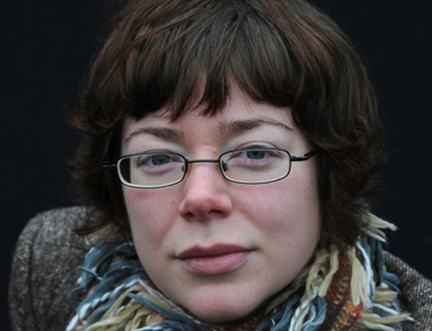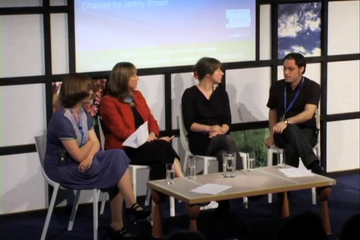From My Vow
By Jen Hadfield
We have commissioned a new piece of writing from fifty leading authors on the theme of 'Elsewhere' - read on for Jen Hadfield's contribution.
From My Vow
the Mexican ex-voto and the secular-sacred in poetry
I The witnessed miracle
From Francisco Trujillo...
Candelaria Arreola...
Miss Josephine Rivera...
from the place where you find Braulio Barrientos...
Al Señor de los milagros...
To our little mother...
our most mysterious...
Before I begin to describe my research visit to Mexico, in the Año Nuevo of 2008 (an account that will reveal that I'm a terrible traveller, being neither courageous, resourceful, social nor spontaneous), I need to deliver a little spiel on Mexican devotional folk-art, in particular, the ex-voto.
This is a votive painting on a small rectangle of tin, reliably possessing a trinity of consistent elements. First, the image of the holy person, generally cushioned by a nimbus of stylised light, occupies one corner of the upper part of the ex-voto. The remaining space is shared by the retablo scene – the depiction of a calamity in which a person finds themself at the moment of the saint's miraculous intervention – and an explanatory text:
I began to pray your novena, and I hadn't even finished when he returned...
for having saved me from a Texan who tried to carry me off...
I ask the Lord of the Conquest that he allow them to give me my liberty...
When the bandit struck me with a dagger, I thought for sure I would lose my life...
The retablista, the artist commissioned to create an ex-voto, strives for as faithful and dramatic a depiction of the miracle as possible. He quizzes his customer for specific visual detail, but he may also take liberties with space and time, in order to best convey the vulnerability of the victim, the extremity of the crisis, the potency of the miracle.
This gives a sort of sci-fi quality to some ex-votos, as in that of M. Esther Tapia Picón (from the Sanctuary of San Juan de los Lagos) who gives thanks to the Virgin of San Juan for saving her family from the migration authorities.
Here, the retablo scene shows the family crouching behind a flimsy shrub in an exposed, arid landscape. The perspective is dream-like, suggesting the viewer crouches with the family and experiences their predicament. In the far distance are city towers, with the quality of mirage. Between the shrub and the city lies the border. Two armed officers patrol it, assisted, despite the broad daylight, by helicopter searchlight. The helicopter is intimidating but the Virgin, in her own formidable lumina, intervenes between its apparent traction beam and the family of M. Esther Tapia Picón.
The customer dictates his text, the retablista acting as scribe, although Don Vincente Barajas, a retablista from Guanajuata, sometimes warns his customers that his spelling isn't very good. 2 There's an absence of formal Latin or liturgy, and the retablista rarely signs his work. The ex-voto becomes a direct line to El Niño de Atocha, or Nuestra Señora de Guadalupe, and this may explain the ambivalence of some priests to the tradition.
A customer might pay $10 or $20 for the commissioned ex-voto, depending on the scene's complexity. A simple depiction of a person praying will cost less than the rendition of a train wreck, a near drowning in the waters of the Rio Grande, or an illegal border crossing.
The text begins and ends with a formula of thanks to the saint for their intervention.
Thank you, my mother!
Restored, I pay my debt...
She made me get better and sent me the check from my accident...
Doy gracias...
Doy infinitas gracias...
II My blasphemous project
Nailed to the walls and tied to the railings of a shrine, ex-votos accumulate, a cloud of good news and crisis weathered, both personal and public; a demonstrative, familiar interchange between the human and the divine.
In Mexico City, I visited formal collections of ex-votos in galleries, in the Museum de Basilica Guadalupe, and in Frida Kahlo's Blue House. Without the passport of faith, I shied away from cathedrals and shrines, abashed by my whiteness, wealth, and my blasphemous project. So I'm dependant upon Durand and Massey's account of the grateful devout, as they queue to enter a shrine, lingering to read each ex-voto, as they find a place to nail or hang their own offering, agreeing how calamitous this event, how miraculous that intervention.
The next time someone asks me who I write poetry for, I will use the analogy of the Mexican ex-voto: the private conversation with the saints, witnessed publicly by the people.
This happened on November 20, 1943 at 7.00 in the evening...
I think of the shrine walls, shedding and renewing their miraculous skin. There, the priests and sacristans have the conundrum of deciding what to do when this anarchic array of miracles occupies all the available space. Ambivalent or not, the priests surely accept that the heart-felt need to hacer patente (make known)the miraculous results of a divine intervention is irrepressible.
This is certainly the attraction of the ex-voto for me, as it also accounts for the nature of what I choose to call poetry, or the honest urge to make it: first, the compulsion to faithfully record and renew the present tense in language which is more spoken than written, while suffering the continual losses of the present tense 3, and second, a more secular, but no less miraculous, intervention.
When I'm making poetry, I'm simultaneously euphoric and winded with loss, walking fast, sitting for hours, working words until my mouth-parts work involuntarily, which makes me feel like some kind of busy beetle. My jaw aches and I digest badly. As I remember it...
I say intervention because without it, any intention on my part to write about landscape, for example, would be, and has always been, a hapless project. When I use the clumsy term secular-sacred, I'm trying to evoke the sensation of a kind of possession or animism. I'm not saying that I am possessed, I'm just saying it feels like it. I feel like a flute-of-me, through which is puffed teaspoonful after teaspoonful of animate air. A night-light burns in a scraped-out pumpkin.
I have come to Mexico to research the ex-voto because I eventually intend to create my own series of secular-sacred ex-votos. I hope to speak less to saints than to characters akin to Juan Soldado, or the murdered bandit, Jesus Malverde, or the gambler, Pedro Blanco. These are described as the Victim Intercessors, secular heroes who die to intercede on behalf of the people 4.
For my own project, The Lucy is a relation to Santa Lucia, who is often portrayed offering up her own plucked eyes in a golden dish, trailing scarlet tails of sinew. The Mater Dolorosa of Mexican Catholicism becomes my Mr Dolorosa.
I hope to turn a gallery into a shrine for ex-votos, representing the prosaic and profound hopes and fears of a fictional North Atlantic people. Breathless with gratitude, winded by wonder; language on their tongue, under the lip, like an ulcer; against the palate like a bean-shaped pearl, the finest that this rolling, tapping, tasting, arching, kneading muscle can form.
In Cuajimoloyas, the walls of the health centre advertise cholera, consumptivo. At worst, my Mexican project is intrinsically fake, rotten with privilege and intention.
III Luck be a lady
My job is first to notice, and second to betray, the halo round everyday language, like the aura that adorns Our Lady of Juquila. I want to illuminate a blurt of spoken language as a peacock illuminates itself with its tail.
I commend myself to The Lucy, a Patron Saint of Nosy Neighbours, Our Lady of the Net Curtain.
I commend myself to The Lucy on the midnight airfield, striding below the turbines of this great ungulate, waving her beacons slowly over her head, as you'd repel a sabre-toothed tiger with fire.
I have good cause to commend myself to a Patron Saint of Eyesight. Last summer, I spent a lot of time considering the rear wall of my left eye. Every few weeks, specialists dilated my pupil, and through that wedged window, photographed my retina, cloudy with shedding cells, rosy with blood and light. They showed me the sweet peach of the macula and the supple trunk of the optic nerve, twisting through the peephole in the screen of my skull. They showed me the progress that their antibiotics and steroids weren't, and finally were, making on a lesion, a fuzzy weal on the retina.
My eye was a snowglobe shook up by the act of frantic looking. Over weeks, my sight cleared as the silt settled, leaving an articulated shadow, a private cartoon, that jinked and spun as I devoured shape, light, colour.
It gradually became apparent that I was going to be lucky but, gingered up on steroids, I could hardly tear myself away from my private cartoon, the antics of the animated protein: now, a dog, biting the base of its tail, now a springbok on a cave-wall, now Will o' the Wisp. My brain peers over it now. With habitude, a memento mori loses its power.
A Patron Saint of Lighthouses; that goes without saying.
I commend myself to The Lucy and her hundred spying satellites, Anik and Amos, Astrid and Cosmos, Doublestar, Echostar, Spaceway and Spot, whose plain names like the names of milk-cows are passed down through their generations.
IV I commend myself to Mr Dolorosa
My obedient fear: of mayonnaise, markets, patrols of the polizio, polizio staring and getting their shoes shined. Fear is speaking and being spoken to. Fear in me is fast as flu. The taxi-driver says, why do you travel alone?
Feral cats fucking in the palazzio, hummingbirds plunging into blooms like syringes. The sun is hot and the shadow cold, and I haiver on their equator, and a red and white cat writhes in the sunny dirt as if she's lapped delicious poison
A man and a woman hold each other below the dome of Santo Domingo; a girl jumps up onto a bench, and yells Papa! and I sit amongst ornamental agaves, and weep sheaves of private-public tears. What the Dominican Friars say – it is not a time for visitors, thank you.
Loneliness is the new, proud-little feather in my cap. I commend myself to Mr Dolorosa, Patron Saint of the Broken-Hearted.
I belong neither to the hostel and its blithe, lithe, bilingual Californians, nor the bird or vendor below the window, sadly calling hecho
hecho
I commend myself to Mr Dolorosa, our dear disreputable sir.
Mr Dolorosa his garland embracing the pilot, addict and smallness rabbit-flea.
The guide Evencio hurries ahead on the trail, calling back the bromeliads and herbs, the mountain mint, and the mountain rose.
I fail to hide my fear of falling. I will trickle down the rock like whey. I'm salt white cheese, queso blanco. Cuidado, says Evencio, as I grope the rock, in which a little cactus is lodged, like an anemone. Tienes miedo? He teaches me how to tell him I'm afraid.
Evencio, perched on the precipice, coaxes me up the rock with crumbs of language, correcting my grammar. Say tengo miedo. Tranquillo...tranquillo. Bonita – the receding blue ridges of the Sierra Norte.
The flat roofs are covered in pale corncobs, and a girl sits amidst them, stripping away the silk. An ox in a pasture of wagging spires of agave. Turkeys boggle. So do Evencio's colleagues when I attempt to say he is a gentleman.
Newness is the nimbus around everyday language. Nopale, Corona di cristo, el chipi rojo.
I perch on a rock behind the graveyard. The rock is littered with stripped cornhusks and the shells of extinguished veladores, the night-lights that are lit at graves and shrines. A road runs below my rock, and a man calls up Tardes! and so does his baritone donkey. Tardes! Good evening! I'm radiant with inclusion. Don't fall! he calls, no caerse!
_________________________________________________________________________________________________
A Dewar Award in 2007/8 funded my trip to Mexico and the resulting exhibition of secular-sacred ex-votos dedicated to fictional saints of the North Atlantic, which was exhibited at StAnza in 2008. Doy gracias.
1. All italicised excerpts from ex-voto texts from Miracles on the Border, Retablos of Mexican Migrants to the United States, Jorge Durand and Douglas S. Massey, The University of Arizona Press, Tucson & London, 1995
- 2026 Festival:
- 15-30 August
Latest News
 Major new partnership with Celtic Connections
Major new partnership with Celtic Connections







